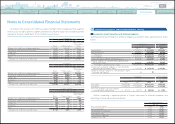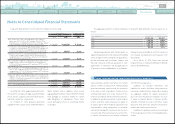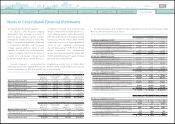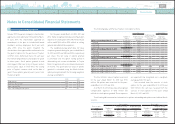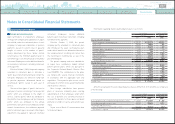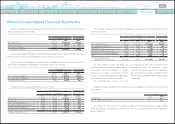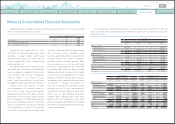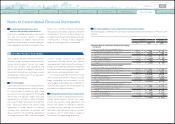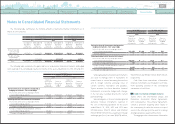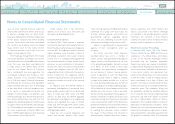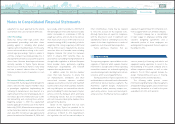Toyota 2012 Annual Report Download - page 103
Download and view the complete annual report
Please find page 103 of the 2012 Toyota annual report below. You can navigate through the pages in the report by either clicking on the pages listed below, or by using the keyword search tool below to find specific information within the annual report.
TOYOTA ANNUAL REPORT 2012
Toyota Global Vision Changes for Making
Ever-Better Cars President
ʼ
s Message Medium- to Long-Term
Growth Initiatives Special Feature Management and
Corporate Information Investor Information
Business and
Performance Review Financial Section
Notes to Consolidated Financial Statements
Employee benefit plans: 19
Upon terminations of employment, employees
of the parent company and subsidiaries in Japan
are entitled, under the retirement plans of each
company, to lump-sum indemnities or pension
payments, based on current rates of pay and
lengths of service or the number of
“
points
”
mainly determined by those. Under normal
circumstances, the minimum payment prior to
retirement age is an amount based on voluntary
retirement. Employees receive additional benefits
on involuntary retirement, including retirement
at the age limit.
Effective October 1, 2004, the parent company
amended its retirement plan to introduce a
“
point
”
based retirement benefit plan. Under the
new plan, employees are entitled to lump-sum
or pension payments determined based on
accumulated
“
points
”
vested in each year of
service.
There are three types of
“
points
”
that vest in
each year of service consisting of
“
service period
points
”
which are attributed to the length of
service,
“
job title points
”
which are attributed to
the job title of each employee, and
“
performance
points
”
which are attributed to the annual
performance evaluation of each employee. Under
normal circumstances, the minimum payment
prior to retirement age is an amount reflecting an
adjustment rate applied to represent voluntary
retirement. Employees receive additional
benefits upon involuntary retirement, including
retirement at the age limit.
Effective October 1, 2005, the parent
company partly amended its retirement plan
and introduced the quasi cash-balance plan
under which benefits are determined based on
the variable-interest crediting rate rather than
the fixed-interest crediting rate as was in the
pre-amended plan.
The parent company and most subsidiaries
in Japan have contributory funded defined
benefit pension plans, which are pursuant to
the Corporate Defined Benefit Pension Plan
Law
(
CDBPPL
)
. The contributions to the plans
are funded with several financial institutions
in accordance with the applicable laws and
regulations. These pension plan assets consist
principally of common stocks, government bonds
and insurance contracts.
Most foreign subsidiaries have pension
plans or severance indemnity plans covering
substantially all of their employees under which
the cost of benefits are currently invested or
accrued. The benefits for these plans are based
primarily on lengths of service and current rates
of pay.
Toyota uses a March 31 measurement date
for its benefit plans.
Information regarding Toyota
ʼ
s defined benefit plans is as follows:
Amounts recognized in the consolidated balance sheet as of March 31, 2011 and 2012 are comprised
of the following:
Yen in millions
U.S. dollars in millions
March 31, March 31,
2011 2012 2012
Change in benefit obligation
Benefit obligation at beginning of year ¥1,726,747 ¥ 1,729,178 $21,039
Service cost 82,422 78,539 956
Interest cost 52,502 52,399 637
Plan participants
ʼ
contributions 1,046 1,055 13
Plan amendments
(
1,429
)
740 9
Net actuarial loss 3,830 117,320 1,427
Acquisition and other
(
57,928
)
40,496 492
Benefits paid
(
78,012
)(
72,340
) (
880
)
Benefit obligation at end of year 1,729,178 1,947,387 23,693
Change in plan assets
Fair value of plan assets at beginning of year 1,179,051 1,183,385 14,398
Actual return on plan assets 24,216 16,309 198
Acquisition and other
(
39,374
)
47,547 578
Employer contributions 96,458 94,815 1,154
Plan participants
ʼ
contributions 1,046 1,055 13
Benefits paid
(
78,012
)(
72,340
) (
880
)
Fair value of plan assets at end of year 1,183,385 1,270,771 15,461
Funded status ¥ 545,793 ¥ 676,616 $ 8,232
Yen in millions
U.S. dollars in millions
March 31, March 31,
2011 2012 2012
Accrued expenses
(
Accrued pension and severance costs
)
¥ 24,677 ¥ 21,076 $ 256
Accrued pension and severance costs 668,022 708,402 8,619
Investments and other assets -
Other
(
Prepaid pension and severance costs
)(
146,906
)(
52,862
) (
643
)
Net amount recognized ¥ 545,793 ¥676,616 $ 8,232
■
Pension and severance plans
0820
Search NextPrev page 103
Contents



